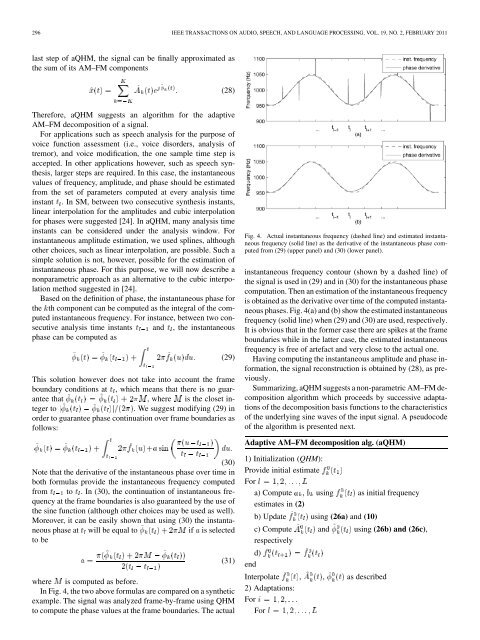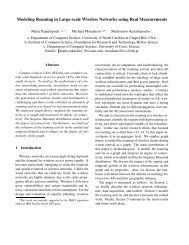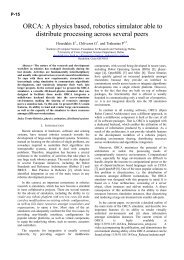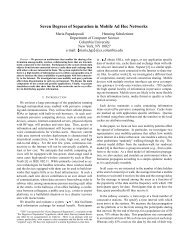Adaptive AM–FM Signal Decomposition With Application to ... - ICS
Adaptive AM–FM Signal Decomposition With Application to ... - ICS
Adaptive AM–FM Signal Decomposition With Application to ... - ICS
You also want an ePaper? Increase the reach of your titles
YUMPU automatically turns print PDFs into web optimized ePapers that Google loves.
296 IEEE TRANSACTIONS ON AUDIO, SPEECH, AND LANGUAGE PROCESSING, VOL. 19, NO. 2, FEBRUARY 2011<br />
last step of aQHM, the signal can be finally approximated as<br />
the sum of its <strong>AM–FM</strong> components<br />
(28)<br />
Therefore, aQHM suggests an algorithm for the adaptive<br />
<strong>AM–FM</strong> decomposition of a signal.<br />
For applications such as speech analysis for the purpose of<br />
voice function assessment (i.e., voice disorders, analysis of<br />
tremor), and voice modification, the one sample time step is<br />
accepted. In other applications however, such as speech synthesis,<br />
larger steps are required. In this case, the instantaneous<br />
values of frequency, amplitude, and phase should be estimated<br />
from the set of parameters computed at every analysis time<br />
instant . In SM, between two consecutive synthesis instants,<br />
linear interpolation for the amplitudes and cubic interpolation<br />
for phases were suggested [24]. In aQHM, many analysis time<br />
instants can be considered under the analysis window. For<br />
instantaneous amplitude estimation, we used splines, although<br />
other choices, such as linear interpolation, are possible. Such a<br />
simple solution is not, however, possible for the estimation of<br />
instantaneous phase. For this purpose, we will now describe a<br />
nonparametric approach as an alternative <strong>to</strong> the cubic interpolation<br />
method suggested in [24].<br />
Based on the definition of phase, the instantaneous phase for<br />
the th component can be computed as the integral of the computed<br />
instantaneous frequency. For instance, between two consecutive<br />
analysis time instants and , the instantaneous<br />
phase can be computed as<br />
(29)<br />
This solution however does not take in<strong>to</strong> account the frame<br />
boundary conditions at , which means that there is no guarantee<br />
that , where is the closet integer<br />
<strong>to</strong><br />
. We suggest modifying (29) in<br />
order <strong>to</strong> guarantee phase continuation over frame boundaries as<br />
follows:<br />
(30)<br />
Note that the derivative of the instantaneous phase over time in<br />
both formulas provide the instantaneous frequency computed<br />
from <strong>to</strong> . In (30), the continuation of instantaneous frequency<br />
at the frame boundaries is also guaranteed by the use of<br />
the sine function (although other choices may be used as well).<br />
Moreover, it can be easily shown that using (30) the instantaneous<br />
phase at will be equal <strong>to</strong> if is selected<br />
<strong>to</strong> be<br />
(31)<br />
where is computed as before.<br />
In Fig. 4, the two above formulas are compared on a synthetic<br />
example. The signal was analyzed frame-by-frame using QHM<br />
<strong>to</strong> compute the phase values at the frame boundaries. The actual<br />
Fig. 4. Actual instantaneous frequency (dashed line) and estimated instantaneous<br />
frequency (solid line) as the derivative of the instantaneous phase computed<br />
from (29) (upper panel) and (30) (lower panel).<br />
instantaneous frequency con<strong>to</strong>ur (shown by a dashed line) of<br />
the signal is used in (29) and in (30) for the instantaneous phase<br />
computation. Then an estimation of the instantaneous frequency<br />
is obtained as the derivative over time of the computed instantaneous<br />
phases. Fig. 4(a) and (b) show the estimated instantaneous<br />
frequency (solid line) when (29) and (30) are used, respectively.<br />
It is obvious that in the former case there are spikes at the frame<br />
boundaries while in the latter case, the estimated instantaneous<br />
frequency is free of artefact and very close <strong>to</strong> the actual one.<br />
Having computing the instantaneous amplitude and phase information,<br />
the signal reconstruction is obtained by (28), as previously.<br />
Summarizing, aQHM suggests a non-parametric <strong>AM–FM</strong> decomposition<br />
algorithm which proceeds by successive adaptations<br />
of the decomposition basis functions <strong>to</strong> the characteristics<br />
of the underlying sine waves of the input signal. A pseudocode<br />
of the algorithm is presented next.<br />
<strong>Adaptive</strong> <strong>AM–FM</strong> decomposition alg. (aQHM)<br />
1) Initialization (QHM):<br />
Provide initial estimate<br />
For<br />
a) Compute , using as initial frequency<br />
estimates in (2)<br />
b) Update using (26a) and (10)<br />
c) Compute and using (26b) and (26c),<br />
respectively<br />
d)<br />
end<br />
Interpolate , , as described<br />
2) Adaptations:<br />
For<br />
For
















